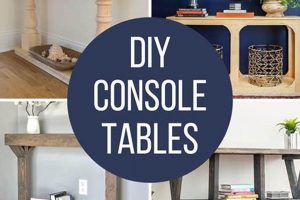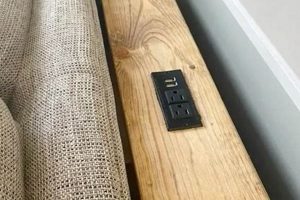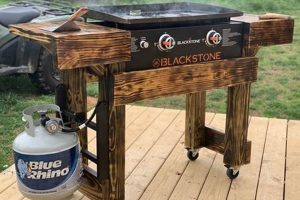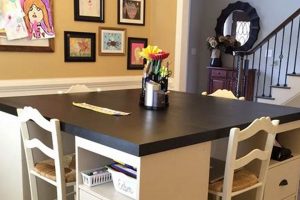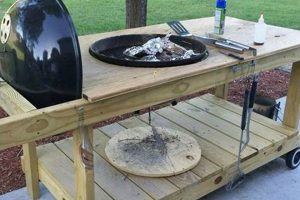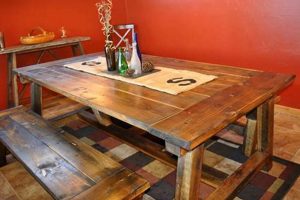A do-it-yourself heated table offers a customizable and potentially cost-effective alternative to commercially manufactured versions. Typically, these projects involve adapting an existing low table by incorporating a heat source and draping a blanket between the tabletop and the frame. This creates a localized warm space ideal for relaxation, dining, or work during colder periods.
The construction of these tables can offer various benefits, including significant cost savings, the ability to customize dimensions and aesthetics to perfectly match a particular living space, and the personal satisfaction derived from creating a functional and unique piece of furniture. The concept draws from traditional Japanese designs, providing a means to adapt this cultural element to diverse settings and individual needs. The adaptability inherent in the project caters to various skill levels and resource availability.
The following sections will delve into the essential components, construction methods, safety considerations, and creative customization options involved in realizing a personalized heated table project. This encompasses material selection, heater integration, assembly techniques, and precautionary measures to ensure safe and efficient operation.
Construction Guidance
Achieving a successful outcome necessitates careful planning and execution. The following guidelines outline critical considerations for building a functional and safe heated table.
Tip 1: Material Selection: Prioritize wood types based on durability and heat resistance. Hardwoods, while more expensive, offer greater stability and longevity compared to softwoods. Evaluate the table’s intended use to determine the appropriate material strength.
Tip 2: Heater Unit Selection: Select a heating element specifically designed for furniture applications. Under-table heaters are readily available and engineered with safety features such as overheat protection and automatic shut-off mechanisms. Ensure the heater’s wattage is appropriate for the table’s size to prevent inefficient heating or potential fire hazards.
Tip 3: Frame Reinforcement: Reinforce the existing table frame to adequately support the weight of the heater and any added components. Employ corner brackets and additional bracing to enhance structural integrity and prevent sagging over time.
Tip 4: Blanket Selection and Placement: Choose a thick, fire-retardant blanket made of natural fibers or specifically designed for heated furniture. Secure the blanket firmly to the table frame, ensuring it does not directly contact the heating element. Adequate blanket coverage is essential for trapping heat and providing a comfortable warmth.
Tip 5: Cord Management: Implement a robust cord management system to prevent tripping hazards and potential damage to the heater’s power cord. Utilize cable ties, cord concealers, or integrated channels to secure the cord and maintain a clean, organized appearance.
Tip 6: Ventilation: Ensure adequate ventilation around the heating element to prevent overheating. Incorporate small openings or gaps in the blanket and frame to allow for airflow, dissipating excess heat and minimizing the risk of malfunctions.
Tip 7: Safety Testing: Before regular use, conduct thorough safety testing. Monitor the table’s temperature during extended operation, inspect for any signs of overheating or electrical issues, and ensure the automatic shut-off mechanism functions correctly.
Adherence to these recommendations will contribute to a durable, safe, and enjoyable experience. Prudent planning and meticulous execution are paramount.
The subsequent segment addresses advanced customization options to personalize the design to individual tastes and requirements.
1. Table Frame Selection
The selection of an appropriate table frame is a foundational element in the construction of a heated table. This choice dictates not only the aesthetic integration of the final product but also directly influences structural integrity, heater compatibility, and overall usability.
- Size and Dimensions
The table frame’s dimensions determine the useable surface area and the amount of space available beneath for legroom and heater placement. An inadequately sized frame may restrict comfortable use, while an overly large frame can be impractical for smaller spaces. Careful consideration should be given to intended use and spatial constraints.
- Material and Durability
The materials used in the table frame’s construction influence its load-bearing capacity and resistance to wear and tear. Solid wood, for example, offers greater strength and durability compared to particleboard or lightweight metals. The selected material must be capable of supporting the weight of the tabletop, heater, and any additional loads imposed during use. Furthermore, the material should resist warping or deformation caused by prolonged exposure to heat from the heater element.
- Structural Stability and Design
A structurally sound table frame is essential for safety and longevity. The frame’s design should provide adequate support to prevent wobbling, sagging, or collapse. Features such as reinforced corners, cross-bracing, and sturdy leg attachments contribute to overall stability. The design must also accommodate the safe and secure mounting of the heater unit, ensuring proper ventilation and preventing direct contact between the heater and combustible materials.
- Aesthetic Compatibility
The table frame’s style and finish contribute significantly to the overall aesthetic appeal of the heated table. The frame should complement the existing dcor of the room and reflect the user’s personal preferences. Consider factors such as wood grain, color, and overall design when making the selection. Aesthetic compatibility enhances the usability and enjoyment of the finished product.
In summary, the table frame selection process is multifaceted, requiring careful consideration of size, material, structural integrity, and aesthetic compatibility. An informed decision at this stage lays the groundwork for a functional, safe, and visually appealing heated table.
2. Heater Element Choice
The selection of the heating element represents a critical juncture in the fabrication of a do-it-yourself heated table. The element directly determines the unit’s heating performance, safety profile, and overall operational cost. Informed selection, therefore, is paramount to the successful completion of the project.
- Wattage Rating and Power Consumption
The wattage rating of the heating element directly impacts its heating capacity and energy consumption. A lower wattage may prove insufficient for adequately warming a larger table, whereas an excessively high wattage can lead to inefficient operation and increased energy costs. The selection should be based on the table’s dimensions and the desired heating level. Consider energy-efficient options to minimize long-term operational expenses.
- Safety Features and Certifications
Prioritizing safety is non-negotiable. The heating element should incorporate essential safety features such as overheat protection, automatic shut-off mechanisms, and tip-over sensors (where applicable). Verify the presence of reputable safety certifications (e.g., UL, ETL) from recognized testing laboratories. These certifications provide assurance that the element has undergone rigorous testing and meets established safety standards, mitigating the risk of fire hazards or electrical malfunctions.
- Element Type and Heat Distribution
Different heating element types, such as radiant heaters, fan-forced heaters, and carbon fiber panels, exhibit varying heat distribution patterns. Radiant heaters provide direct, localized heat, while fan-forced heaters circulate warm air for more even distribution. Carbon fiber panels offer efficient and uniform heating. The choice of element type should align with the intended usage and desired comfort level. Even heat distribution prevents hot spots and ensures a more consistent warming experience.
- Mounting Configuration and Compatibility
The heating element’s mounting configuration must be compatible with the table frame’s design and construction. The element should be securely mounted to prevent accidental dislodgement or contact with flammable materials. Adequate clearance should be maintained around the element to facilitate proper ventilation and prevent overheating. Verify the element’s dimensions and mounting requirements before purchase to ensure seamless integration with the table frame.
Careful consideration of wattage, safety features, element type, and mounting configuration is essential for optimizing the functionality and safety of a personalized heated table. Neglecting these aspects can compromise performance, increase the risk of accidents, and diminish the overall value of the undertaking.
3. Blanket Material Safety
In the context of constructing a personalized heated table, blanket material safety constitutes a critical consideration due to the inherent proximity of the fabric to a heat source. The potential for ignition or the release of toxic fumes from unsuitable materials introduces a significant safety hazard. Selection of an appropriate blanket material directly impacts the fire safety profile of the finished table, influencing both the likelihood of a fire and the severity of any potential combustion event. For instance, using a synthetic material with a low melting point near a high-wattage heater could result in melting, off-gassing, and ultimately, ignition. Real-life incidents involving space heaters and flammable fabrics underscore the importance of stringent material selection criteria.
Implementing appropriate safeguards necessitates employing materials characterized by inherent flame resistance or those treated with fire-retardant chemicals. Natural fibers such as wool or cotton, while not inherently flameproof, tend to char rather than burst into flames, providing a measure of protection. Furthermore, the thickness and weave density of the fabric influence its heat resistance. A tightly woven, thicker blanket offers greater insulation and reduces the risk of direct heat transfer to underlying surfaces. Regular inspection of the blanket for wear and tear, particularly near the heating element, serves as a preventative measure. Substitution of damaged or compromised blankets with appropriate replacements mitigates potential safety risks.
Therefore, diligent attention to blanket material safety represents a non-negotiable aspect of crafting a personalized heated table. Selecting appropriate materials, implementing preventative maintenance, and adhering to established safety guidelines are essential for minimizing the risk of fire and ensuring a safe and enjoyable experience. Failure to address this crucial aspect can result in property damage, injury, or even loss of life. This reinforces blanket selection and maintanence should be prioritized.
4. Cord Management Solution
The implementation of a robust cord management solution is an integral component of any well-executed heated table project. The uncontrolled presence of power cords poses significant safety risks and detracts from the overall aesthetic appeal of the finished product. A carefully considered system mitigates hazards and enhances functionality.
- Trip Hazard Mitigation
Exposed power cords create a substantial tripping hazard, particularly in frequently trafficked areas. The risk is amplified when individuals are moving around a table, often with limited visibility. A cord management system, such as concealed channels or secure clips, eliminates this hazard by routing cords safely away from walking paths. Real-world incidents involving trips and falls due to loose cables underscore the importance of proactive cord management.
- Electrical Safety and Cord Protection
Unmanaged cords are vulnerable to damage from pinching, abrasion, and accidental cuts. Such damage can compromise the insulation and expose live wires, creating a risk of electrical shock or fire. A well-designed cord management system shields the cord from physical damage, extending its lifespan and ensuring electrical safety. Examples include the use of protective sleeving, strain relief mechanisms, and secure anchoring points.
- Aesthetic Integration and Visual Order
The presence of tangled or dangling cords detracts from the overall aesthetic appeal of the heated table. A cord management system promotes visual order by concealing or neatly arranging cords, creating a clean and professional appearance. Solutions such as cable ties, cord organizers, and integrated channels contribute to a more visually pleasing and uncluttered environment.
- Accessibility and Maintenance
While concealment is desirable, the cord management system should also allow for reasonable accessibility for maintenance or troubleshooting. The system should permit easy access to the power cord for inspection, replacement, or temporary disconnection. Overly complex or restrictive systems can hinder maintenance efforts and increase the likelihood of damage during attempts to access the cord. Thoughtful design balances aesthetics with practical accessibility.
In conclusion, the effective management of cords is not merely an aesthetic consideration but a fundamental aspect of safety and functionality. A properly implemented system enhances the overall quality and usability of a personalized heated table, minimizing risks and maximizing user satisfaction. The benefits extend beyond mere appearance, contributing to a safer and more practical living space.
5. Temperature Control Device
The integration of a temperature control device into a do-it-yourself heated table project constitutes a crucial element for ensuring both user comfort and operational safety. This device serves as an intermediary between the power source and the heating element, regulating heat output and preventing potentially hazardous overheating scenarios. Its inclusion transforms a simple heat source into a controllable and safe amenity.
- Thermostat Functionality
A thermostat, acting as a temperature control device, monitors the heating element’s temperature. Upon reaching a preset threshold, it interrupts the electrical circuit, ceasing heat generation. Conversely, when the temperature drops below the setpoint, the thermostat reactivates the circuit, restoring heat. This cyclical operation maintains a stable and consistent temperature within the heated table environment. Analog thermostats employ bimetallic strips or gas-filled bellows to sense temperature changes, while digital thermostats utilize thermistors or thermocouples for enhanced accuracy and control. Examples of thermostats used in heated blankets illustrate the application of this technology in similar low-voltage heating scenarios.
- Overheat Protection Mechanisms
Beyond basic temperature regulation, temperature control devices frequently incorporate overheat protection mechanisms. These mechanisms act as fail-safes, triggering circuit interruption in the event of a malfunction or unforeseen circumstance that causes the heating element to exceed a critical temperature. Thermal fuses, resettable thermal cutouts, and temperature limit switches are common examples. These devices prevent catastrophic overheating, mitigating the risk of fire or component damage. Industrial temperature controllers with built-in safety interlocks showcase the application of comparable technologies in high-power heating systems.
- Adjustability and User Preferences
The capacity for user-adjustable temperature settings enhances the versatility and user experience of a heated table. Temperature control devices offering multiple heat settings or precise temperature adjustments empower users to tailor the warmth output to their individual preferences and ambient environmental conditions. Rotary dials, push-button controls, and digital interfaces provide different methods for adjusting temperature. Variable temperature settings found in electric blankets illustrate the benefit of user control over heat output.
- Energy Efficiency Considerations
A well-designed temperature control device contributes to energy efficiency by preventing unnecessary energy consumption. By accurately maintaining the desired temperature, the device minimizes overshooting and cycling, reducing the overall power demand. Programmable thermostats, incorporating time-based temperature schedules, further optimize energy usage by automatically lowering the temperature during periods of inactivity. Smart thermostats used in residential heating systems exemplify the potential for advanced energy management.
The multifaceted role of the temperature control device extends beyond simple heating. Its integration into a do-it-yourself heated table ensures consistent comfort, prevents hazardous overheating, allows for personalized temperature preferences, and contributes to energy conservation, reinforcing the device’s vital role in the project’s success and safety.
6. Ventilation Sufficiency
Ventilation sufficiency is a non-negotiable design parameter for safe and effective personalized heated tables. Insufficient ventilation directly leads to the accumulation of heat within the table’s enclosure, creating a cascade of potential hazards. The lack of adequate airflow restricts the dissipation of heat generated by the electrical heating element, escalating the risk of overheating, thermal runaway, and, in extreme cases, ignition of surrounding materials. The direct causal link between restricted ventilation and elevated fire risk underscores its paramount importance.
The incorporation of ventilation openings or strategically designed air gaps within the table’s structure facilitates convective heat transfer. These openings allow cooler ambient air to enter the enclosure, displacing the heated air and promoting continuous airflow. The size and placement of these ventilation points directly influence the efficiency of heat dissipation. Examples can be found in commercially available heated furniture, where ventilation grilles are deliberately integrated into the design to ensure safe operating temperatures. Failure to adequately ventilate a heated table replicates the conditions that lead to overheating in electronic devices, where restricted airflow can cause component failure and even combustion.
Achieving ventilation sufficiency requires careful consideration of the heating element’s wattage, the table’s internal volume, and the thermal properties of surrounding materials. Testing the table’s operating temperature under simulated use conditions provides valuable data for optimizing ventilation design. Challenges often arise in balancing ventilation requirements with aesthetic considerations; however, prioritizing safety is essential. In summary, ventilation sufficiency is a foundational element, directly impacting user safety and the overall reliability of personalized heated tables. Its importance cannot be overstated.
7. Structural Stability
Structural stability is a paramount consideration in the design and construction of a do-it-yourself heated table. The table must be capable of supporting not only its own weight but also the weight of the heating element, the covering blanket, and any objects or individuals that may rest upon it during use. Compromised stability poses significant safety risks and reduces the lifespan of the furniture.
- Material Selection and Load-Bearing Capacity
The choice of materials directly dictates the load-bearing capacity of the table. Solid hardwoods possess greater strength and resistance to deformation compared to softwoods or composite materials. The selected materials must be able to withstand the anticipated static and dynamic loads without exhibiting excessive deflection or failure. For example, a table constructed from thin particleboard may buckle under the weight of a heater and blanket, whereas a table built from reinforced hardwood would provide adequate support.
- Joint Integrity and Connection Strength
The integrity of the joints and connections between the table’s components is crucial for maintaining overall structural stability. Weak or poorly constructed joints can lead to instability, wobbling, and eventual collapse. Methods such as mortise and tenon joints, dovetail joints, or reinforced screw connections enhance joint strength and prevent separation under load. An example of poor joint integrity would be a table with legs attached using only small screws, which are prone to pulling out under stress, while a table with properly constructed mortise and tenon joints would exhibit far greater stability.
- Frame Reinforcement and Support Systems
The incorporation of frame reinforcement elements, such as cross-bracing, aprons, or corner blocks, enhances the table’s resistance to racking and distortion. These elements distribute loads more evenly and prevent localized stress concentrations. A table lacking adequate frame reinforcement may exhibit excessive wobble or twisting under uneven loads, while a table with properly implemented reinforcement will maintain its shape and stability. The principle is similar to the use of trusses in bridge construction to distribute weight and prevent structural failure.
- Leg Design and Weight Distribution
The design and placement of the table legs significantly impact weight distribution and stability. Legs that are too thin or positioned too close together may result in an unstable structure. Flared legs or legs with a wider footprint provide greater stability and prevent tipping. The legs must be securely attached to the table frame using robust fasteners or joinery techniques. A table with poorly designed or improperly attached legs is prone to tipping over, particularly when subjected to uneven loads, while a table with well-designed and securely attached legs provides a stable and reliable support surface.
In summary, achieving adequate structural stability requires careful attention to material selection, joint construction, frame reinforcement, and leg design. A well-engineered table will provide a safe, reliable, and long-lasting platform for enjoying the benefits of a do-it-yourself heated table. Neglecting these considerations can result in a compromised structure that poses safety risks and diminishes the overall value of the project.
Frequently Asked Questions
This section addresses common inquiries and misconceptions surrounding the fabrication of personalized heated tables. The intent is to provide clear, concise answers to guide project planning and execution.
Question 1: What is the optimal wattage for a heating element in a heated table?
The appropriate wattage depends on the table’s surface area and desired heating level. A general guideline is 10-15 watts per square foot. Higher wattage may be necessary for larger tables or colder environments. It is imperative to adhere to the manufacturer’s safety guidelines for the selected heating element.
Question 2: What are the primary safety concerns associated with heated tables?
Overheating, electrical shock, and fire hazards are the principal safety concerns. Proper ventilation, the use of certified heating elements with safety features, and careful cord management are essential mitigation strategies.
Question 3: Can any type of blanket be used with a heated table?
No. Only fire-retardant blankets constructed from natural fibers or specifically designed for heated furniture should be used. Synthetic materials with low melting points pose a significant fire hazard.
Question 4: How frequently should a heated table be inspected for safety?
A thorough safety inspection should be conducted before each use, paying particular attention to the heating element, power cord, and blanket material. More comprehensive inspections, including testing of safety features, should be performed monthly.
Question 5: Is it possible to construct a heated table suitable for outdoor use?
While possible, outdoor applications require careful consideration of weather resistance and electrical safety. The heating element and wiring must be appropriately shielded from moisture and the table’s structure must be durable enough to withstand environmental conditions. Professional electrical consultation is strongly advised.
Question 6: What is the expected lifespan of a properly constructed and maintained heated table?
The lifespan depends on the quality of materials, construction techniques, and usage patterns. With proper care and maintenance, a well-built heated table can provide several years of reliable service.
In summary, the successful and safe construction of a personalized heated table hinges on informed planning, meticulous execution, and consistent adherence to safety protocols.
The subsequent section delves into the creative aspects of heated table design, exploring customization options and aesthetic considerations.
Concluding Remarks on Do-It-Yourself Heated Tables
The preceding exploration has outlined critical factors governing the successful creation of a functional and safe do-it-yourself heated table. Key aspects encompassed material selection, heating element specifications, safety protocols, and structural considerations. Adherence to these principles mitigates risks associated with electrical and thermal hazards, ensuring a durable and reliable product.
The information presented serves as a foundation for informed decision-making and responsible execution. Prospective builders are encouraged to prioritize safety throughout the design and construction process. Continued vigilance in maintenance and adherence to established guidelines will contribute to the longevity and safe operation of the unit. The application of these principles fosters both personal well-being and resource efficiency.


